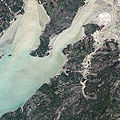Joggins
Joggins, Nova Scotia, Canada, is famous for its fossils dating to the Pennsylvanian 'Coal Age' of Earth history.[1] On July 7, 2008 a 15 km length of the coast comprising the Joggins Fossil Cliffs was officially inscribed on the World Heritage List.[2]
Community | |
 | |
| Coordinates: 45°41′30.78″N 64°26′36.85″W / 45.6918833°N 64.4435694°WCoordinates: 45°41′30.78″N 64°26′36.85″W / 45.6918833°N 64.4435694°W | |
| Country | |
| Province | |
| Municipality | Cumberland County |
| Incorporated | 1889 |
| Time zone | UTC-4 (AST) |
| Official name | Joggins Fossil Cliffs |
| Type | Natural |
| Criteria | viii |
| Designated | 2008 (32nd session) |
| Reference no. | 1285 |
| State Party | Canada |
| Region | Europe and North America |
The dating of this site has been debated, with dates from 320 million years ago (mya) to 305 mya being suggested.[3]p39 It is now settled as 314.5–313.4 mya +/- 1.1 million years.[3]p40
Joggins Fossil Cliffs
The dramatic coastal exposure of the Coal Age rocks, known as the Joggins Fossil Cliffs, are continually hewn and freshly exposed by the actions of the tides in the Cumberland Basin. Geologists were first attracted to this locality in the late 1820s.[4] A little later, the first student party studied Joggins in 1835[5]
However, the true fame of Joggins dates from the visits in 1842 and 1852 by Charles Lyell, the founder of modern geology and author of Principles of Geology. In his Elements of Geology (1871), Lyell called the Joggins exposure of Coal Age rocks and fossils "the finest example in the world".[6] The fossil record at Joggins figures in Charles Darwin's On the Origin of Species, and played a role in the 1860 Oxford evolution debate between Thomas Huxley and Bishop Wilberforce.
- "Mssrs. Lyell and Dawson found carboniferous beds 1400 feet thick in Nova Scotia, with ancient root-bearing strata, one above the other, at no less than 68 different levels..." Charles Darwin 1859. On the Origin of Species, p296.
Much of the early work to document the fossil record at Joggins was by Nova Scotian geologist William Dawson (1820–1899), who had a close personal and working relationship with his friend and mentor Charles Lyell. Much of Dawson's collection is in the Redpath Museum of McGill University.
In 1852 Lyell and Dawson made a celebrated discovery of tetrapod fossils entombed within an upright tree at Coal Mine Point. Subsequent investigations by Dawson led to the discovery of one of the most important fossils in the history of science, Hylonomus lyelli, which remains the earliest known reptile in the history of life, but not the earliest known amniote. In 2002, Hylonomus lyelli was named the provincial fossil of Nova Scotia.
Trackways are preserved at the Joggins Fossil Cliffs. The tree-like lycopod Sigillaria is preserved in situ.
Recent work
There has been a surge in interest in Joggins over the past 20 years.[4] A thesis by Mike Rygel significantly advanced understanding of the site's history, stratigraphy, sedimentology and biota after the century of neglect which followed Dawson's death in 1899.[4]
Important fossil
A vital early tetrapod fossil has been found here, the earliest synapsid, Protoclepsydrops, which is actually earlier than Hylonomus.[3]
World Heritage Site
In 2007, a 15 km length of the coast comprising the Joggins Fossil Cliffs was nominated by Canada to UNESCO as a natural World Heritage Site. It was officially inscribed on the World Heritage List in on July 7, 2008.[2]
Joggins Media
An upright tree-like fossil (a lycophyte such as Sigillaria) preserved in the cliffs at Joggins, Nova Scotia
Sigillaria lycopod fossil, showing its bark impression (Canadian one dollar coin, 26.5mm for scale)
Calamites (horsetail) fossil
Beach, showing Carboniferous stratification
References
- ↑ Falcon-Lang H.J. et al. 2010. Classic localities explained 4: Joggins, Nova Scotia. Geology Today 26 (3): 108-114.
- ↑ 2.0 2.1 "UNESCO portal". Archived from the original on 2010-01-05. Retrieved 2020-09-15.
{{cite web}}: CS1 maint: bot: original URL status unknown (link) - ↑ 3.0 3.1 3.2 Benton M.J. and Donoghue P.C.J. 2006. Palaeontological evidence to date the tree of life. Molecular biology and evolution. 24(1): 26–53. [1]
- ↑ 4.0 4.1 4.2 Falcon-Lang H.J. 2006. A history of research at the Joggins Fossil Cliffs, the world’s finest Pennsylvanian section. Proceedings of the Geologists’ Association 117(3): 377-392
- ↑ Falcon-Lang H.J. 2009. The 1835 Williams College expedition to Atlantic Canada: The first geological fieldtrip by a North American college. Atlantic Geology 45:95–109
- ↑ "Joggins Fossil Cliffs website". Archived from the original on 2010-01-05. Retrieved 2011-09-27.
{{cite web}}: CS1 maint: bot: original URL status unknown (link)
![]()





